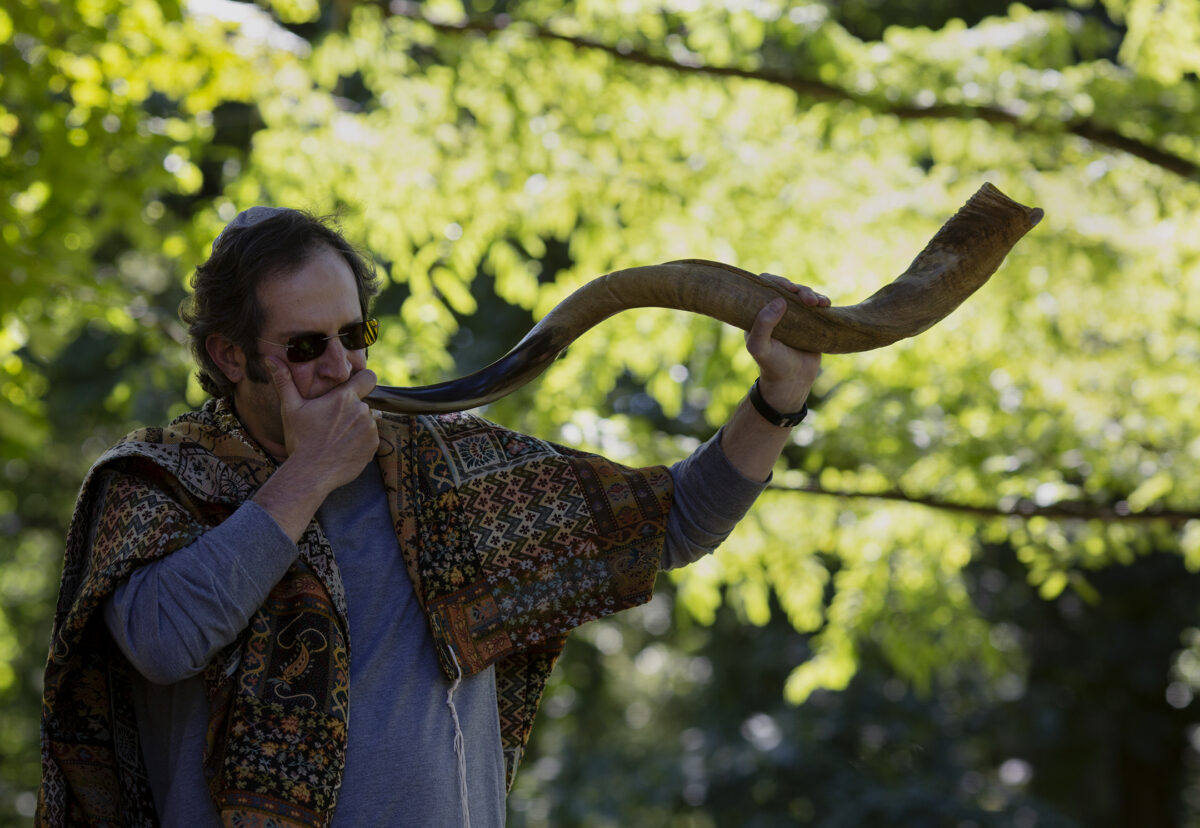ESSAY:
Shofars and the Pandemic

Ken Rubin blows a shofar in a Bexley, OH park for Rosh Hashanah in 2020. Photograph by Lauren Pond.
Collage of shofars being blown outdoors for Rosh Hashanah in 2020. Recordings by Erin Allen, Steve Gordon, Jon Grischkan, Lauren Pond, and Isaac Weiner; production by Lauren Pond.
There are many meanings associated with the sounding of the shofar. It offers a symbolic “wake-up” call, summoning listeners to change their ways and repent. It stirs its hearers to take action in the world, to recognize that repentance is a communal, outward-facing act as much as a personal, inward-facing one and to take action to repair the social fabric. The shofar is said to denote the majesty and authority of God, and it also evokes the ram that Abraham sacrificed in place of his son, Isaac, in the famous Biblical account read in synagogues on the second day of Rosh Hashanah. In so doing, the shofar serves as a call to God as much as to God’s people, reminding God of Abraham’s devotion and pleading for forgiveness on his account. Regardless of the particular meanings assigned to its call, for many the shofar sounding is simply a beloved tradition that conjures strong memories and emotions, linked to observance of High Holidays past. Children frequently gather at the front of the sanctuary to watch and listen, their imaginations stirred by the unusual playing of an unusual instrument during formal Jewish worship. It is a key marker of the specialness and distinctness of the High Holidays from other times of the Jewish year.
Over the summer of 2020, as they prepared for the High Holidays, American Jewish communities debated what to do about the shofar. Because of the ongoing COVID-19 pandemic, most synagogues determined that it was not safe to gather for large in-person services. While some held small services, with limited numbers of people observing social distancing and wearing masks, most others shifted online. Even so, many worried that it would not “feel” like the High Holidays if they did not hear the shofar in person. Different rabbis came to different conclusions about whether the mitzvah of hearing the shofar could even be fulfilled online or whether it had to be heard in person. Yet sounding the shofar also posed particular challenges during a time of global pandemic because of the risk that it would spray aerosol droplets across wide swaths of space.
The pandemic prodded many religious communities to creatively reimagine their traditional observances, and the sounding of the shofar was no exception. In cities across the country, Jewish congregations decided to detach the shofar blowing from the main liturgy of the morning service and to assemble at alternate times, outdoors, to hear its blast. They gathered in parks and in parking lots, on street corners and in neighbors’ yards, transforming all sorts of public spaces into settings for religious ritual.
In Bexley, Ohio, for example, a suburb of Columbus, Congregation Agudas Achim organized multiple outdoor shofar ceremonies on the first day of Rosh Hashanah, in order to keep numbers low at each. In the morning, they held somewhat abbreviated services in their main sanctuary, open only to small numbers of congregants and broadcast via livestream to the rest of the community. In the afternoon, the Conservative synagogue arranged for different shofar blowers to spread out around the city, staking out positions on street corners and in public parks. Small groups of congregants gathered around them at a safe distance. For many, it was the first time they had assembled in person with fellow congregants since the start of the pandemic, making the small, intimate shofar ceremonies important social rituals as much as religious ones.
People socialize before and after a 2020 outdoor shofar blowing in Bexley, OH for Rosh Hashanah. Recording by Lauren Pond.
A 2020 outdoor shofar blowing for Rosh Hashanah at Cassingham Park in Bexley, OH. Recording by Isaac Weiner.
If one outcome of the pandemic was religious practices shifting inward to the home or online to virtual spaces, then the shofar ceremonies demonstrate how communities also turned outward, practicing their religions publicly in new ways. And as a public ritual, the shofar services made Jews audible to others. It was not just those who chose to attend Rosh Hashanah services in the synagogue who would hear the shofar’s sound, but anyone who happened to be playing in the park or walking down the street. The public blasting of the shofar expanded what we might describe as the “acoustic community” constituted by its call.
Making oneself audible to others can be a powerful form of outreach and engagement, but it also renders one vulnerable, subject to scrutiny and unwanted attention. Historically, Jews only sounded the shofar in public in contexts where they were politically dominant, as in the modern state of Israel. During the middle ages and in early modern Europe, Christian rulers often prohibited Jews from engaging in public worship or other acts of religious noise-making. Jews often chose to keep quiet on their own, out of concern for their safety. To call attention to themselves might be to invite unnecessary trouble.
To sound the shofar in public, then, in 2020, in the United States, was also to assert a sense of security and belonging. During a time when antisemitic bigotry was on the rise, American Jewish communities responded by making themselves heard, loudly and confidently. With the blasts of the shofar, they called out to God, to each other, and to others, re-affirming the value of their traditions and their community amidst a time of unprecedented turmoil and uncertainty. As pandemic restrictions begin to ease, we will see (hear?) whether Jews will continue to sound the shofar in public or whether they will return to the space of the synagogue and formal worship. How else might the sound of American Jewish practice change in the years to come?
– Isaac Weiner